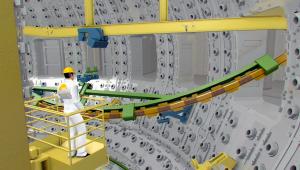Roll them, turn them, bolt them: ITER assembly in high definition
The arrival of the first components on the ITER site will be the starter pistol for one of the most complex stage shows ever performed: the assembly of the ITER machine. In a first video back in 2011—The world's largest puzzle—we explained the challenging task of assembling the cryostat.
In a new video titled Roll them, turn them, bolt them, the job is taken one step further as we look at the installation of ITER's in-vessel components such as the in-vessel coils, the blanket system and the divertor. None of these are easy tasks and a set of custom-made tools, platforms and cranes will be needed to transfer the bulky components from the Assembly Building, through port cells and into their final positions.
The production of this eight-minute animation was certainly not as challenging as the assembly of the world's largest fusion device, yet it was no small matter. Some 31,688 individual objects had to be managed per scene requiring the experienced hands of four graphic artists and animation specialists from the German-based company Motion-e-Motion. Their job was to sort out vast CATIA data sets describing the ITER machine, to reduce them, and then to "map, shade and rig" (in video terms). Eight computers with powerful Intel i7 processors took on the job, sweating for 168 long hours to render the data into a high-definition movie.


